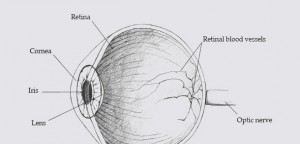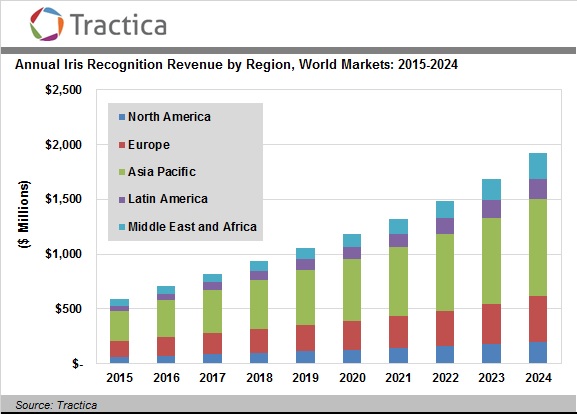You are here:
Frequently Asked Questions: Iris recognition, iris biometrics and iris scanning
Comprehensive Q&A resource for iris recognition, iris biometrics and iris scanning
Iris recognition 101
Iris recognition – also commonly referred to iris biometrics or iris scanning – is the process of identifying or authenticating an individual by analyzing the unique, random patterns in the iris portion of the eye. The iris is a muscle within the eye that regulates the size of the pupil in order to control the amount of light that enters the eye. It is the colored ring of the eye and its patterns are absolutely unique to each individual. The idea of using the iris for biometric identification is first attributed to Frank Burch in 1936, however it was not until the1990s that significant progress began.
Iris recognition systems capture a high-resolution digital image or photo of a person’s iris. Unique points and details of the iris image are pinpointed and a mathematical algorithm is used to create a numeric template representing these points. This string of digits that makes up the template is stored or enrolled for later comparison, and the actual image of the iris is discarded.
In subsequent identification or authentication attempts, the individual’s iris is again photographed and the same algorithm applied. The resulting numeric template is compared to the enrolled template or all templates in a database to see if a match can be made.
Iris recognition articles from SecureIDNews
The eyes have it: Has the time for iris biometrics come?
Biometric Trends: Will emerging modalities and mobile applications bring mass adoption?
Researchers target iris templates
Iris vs. retina biometrics yes, they really are different
To access hundreds more articles on iris recognition at SecureIDNews, click here.
To review the most recent articles on iris recognition, click here.
FAQ
What is an iris template?
An iris template is a digital representation of an individual’s iris patterns. The template is a numeric representation of information extracted from a biometric sample or image of the iris. In an iris recognition system, it is these biometric templates – not the iris images– that are actually compared. The comparison of a stored biometric template to a template presented at the time of a transaction is called a biometric match. Thus, iris biometric matching compares the stored or enrolled iris template against the new iris template created from a captured iris image.
Advantages of iris recognition
Compared to other biometric modalities, there a series of unique strengths of iris recognition that make it an ideal technology in certain environments.
- Enrollment and subsequent capture is a contactless biometric or touchless biometric process. Thus, hygiene concerns are minimized, as the subject need not physically come in contact with the biometric scanner or sensor
- Iris is protected and less prone to injury that could cause problems with biometric capture and future matching
- Iris is highly stable over the lifetime of the individual after the first year of life
- Iris has a very small outlier population, the term given to the group of people unable to use it for various reasons
- Use requires very little involvement, cooperation or training on the part of the user
Disadvantages of iris recognition
Similarly, there are weaknesses of iris recognition that make it less ideal than other biometric modalities in certain situations.
- Public myths and fears related to “scanning” the eye
- Lack of existing databases deters ability to use for background or watchlist checking
- Can be obscured by eyelashes, eyelids, lens and reflections from cornea
- Iris scanners and solutions have traditionally been more expensive than other biometric modalities
- Cannot be verified by human eye
Can identical twins be differentiated using iris recognition?
Although identical twins look the same in many ways, key biological characteristics such as fingerprints and iris patterns are unique. Thus, identical twins can be differentiated and cannot spoof one and other in an iris scanning system.
Does the iris change over time?
During the first year of life there is some development or stabilization of the iris, but following the first year, an individual’s iris patterns remain consistent throughout life. This fact makes iris a better solution than other modalities when it will be used as an identifier over long periods of time or throughout a lifetime.
What is iris authentication?
Iris authentication – like iris verification — is the process whereby a biometric system attempts to confirm an individual’s claimed identity by comparing a submitted iris sample in the form of a template to previously enrolled iris templates. Iris authentication involves a one to one (1:1) search in which a submitted sample is checked against a single enrolled template.
What is iris verification?
Iris verification – like iris authentication — is the process whereby a biometric system attempts to confirm an individual’s claimed identity by comparing a submitted iris sample in the form of a template to previously enrolled iris templates. Iris verification involves a one to one (1:1) search in which a submitted sample is checked against a single enrolled template.
What is iris identification?
Iris identification is the process whereby a biometric system attempts to determine the identity of an individual by comparing a submitted or captured iris sample in the form of a template to a database of existing iris templates. Iris identification involves a one to many (1:N) search in which a submitted sample is checked against all templates stored in a database.
What is iris recognition?
Iris recognition is a generic term that is commonly used to describe any iris biometric matching process. It is used to describe both one to one matching (1:1) referred to as either iris verification or iris authentication as well as one to many matching (1:N) referred to as iris identification.
What is an iris scanner?
An iris scanner is a generic term that describes any type of hardware used as an iris biometric reader or iris image capture device.
What is iris enrollment?
Iris enrollment is the process of initially capturing or scanning an individual’s iris – essentially taking a photograph of the eye — and processing that image using iris recognition software to create a unique iris biometric template. This initial template is known as an iris biometric reference template, and it is used as the reference to be matched against during future authentication or identification events.
What is iris capture?
Iris capture is the generic term used to describe the process of photographing or otherwise capturing an image of the iris for the purpose of creating a template for either initial enrollment in an iris biometric system or subsequent matching.
Can iris be read at a distance or on the move?
In the early implementations of iris recognition systems, the iris image was captured at a very close range and via deliberate positioning of the individual’s eye in reference to the iris scanner. This was a limiting factor for use of the iris modality as it forced strict use cases. In the mid-2000s, technology advancements enabled iris images to be captured from greater distances and even from individuals in motion. Iris at distance and iris on the move became taglines for products offering these more flexible use cases.
What is the difference between iris recognition and retinal scanning?
 Though commonly mistaken as the same technology, iris and retina biometrics are completely different technologies. Iris recognition relies on unique patterns in the human iris while retina scanning relies on blood vessel patterns in the retina deep within the eye. While iris recognition has become an important and highly used modality, retinal scanning is seldom used.
Though commonly mistaken as the same technology, iris and retina biometrics are completely different technologies. Iris recognition relies on unique patterns in the human iris while retina scanning relies on blood vessel patterns in the retina deep within the eye. While iris recognition has become an important and highly used modality, retinal scanning is seldom used.
For more on the differences between iris recognition and retinal scanning, check out the article: Iris vs. retina biometrics yes, they really are different
Do contact lenses or eyeglasses impact iris recognition?
Typically contacts and glasses do not affect the performance of iris recognition systems, but colored or pattern lenses may derail some iris scanners. While soft contacts are immune, glasses and hard contacts can create glare that makes it tough to capture a good image. In modern systems, neither contacts nor glasses can be used to purposely spoof or derail iris recognition.
Does Lasik or other eye surgeries impact iris recognition?
Lasik or other eye surgeries do not impact iris recognition because these medical procedures don’t change the patterns of the iris.
Is iris scanning dangerous for the eye?
The iris scanning or iris capture process simply photographs the iris either at a distance or at close range. Despite common misconceptions, there is no laser or other scanning device involved. Typically a standard digital camera – the same technology in a home video camera – is used to capture the image at enrollment and subsequent verification events.
Can an iris image be reverse engineered from an iris template?
Once a numeric, mathematical iris template is created from the captured iris image, there is no way to recreate an actual image from the template. This threat or attack on a biometric system — commonly called reverse engineering — is a fundamental element protected against in secure biometric systems. In any well-designed iris biometric system, the actual images are never stored. Instead they are discarded once the template has been created. If an iris biometric template is stolen, it is essentially useless, as it contains no legible information about the individual and no visible image.
How long does it take to process an image and check the resulting template against a database?
It generally takes less than 2 seconds to process an image and create a template. The time required to match that template against the database of enrolled templates depends on the number of records in that database, among other things, but typically takes just seconds for a one to one (1:1) authentication. Depending on the size of the database, it can take longer for a one to many (1:N) identification of a subject.
How large is the market for iris recognition technology?
According to a report by market research firm, Tractica, the iris biometric market reached $587 million in 2015, but the global revenues are forecast to increase by 400%, reaching $1.92 billion by 2024. The cumulative revenue for the 10-year period is predicted to reach $11.7 billion at a compound annual growth rate of 14%.

